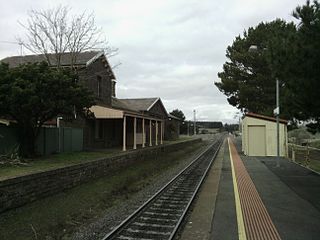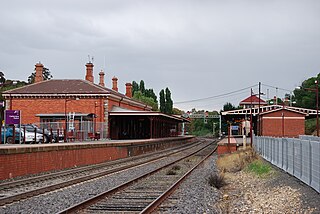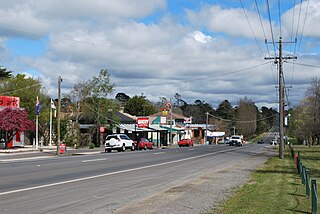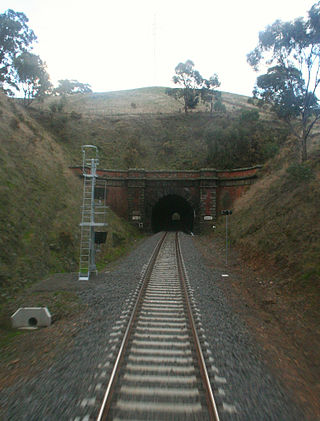
Bendigo is a city in Victoria, Australia, located in the Bendigo Valley near the geographical centre of the state and approximately 150 kilometres (93 mi) north-west of Melbourne, the state capital.

Kyneton railway station is located on the Deniliquin line in Victoria, Australia. It serves the town of Kyneton, and opened on 25 April 1862.

Malmsbury railway station is located on the Deniliquin line in Victoria, Australia. It serves the town of Malmsbury, and it opened on 21 October 1862.

Castlemaine railway station is located on the Deniliquin line in Victoria, Australia. It serves the town of Castlemaine, and it opened on 21 October 1862.
The Melbourne, Mount Alexander and Murray River Railway Company was a railway company in Victoria, Australia. It was established on 8 February 1853 to build a railway from Melbourne to Echuca on the Victorian-NSW border and a branch railway to Williamstown. The company struggled to make any progress and on 23 May 1856, the colonial government took over the company and it became part of the newly established Department of Railways, part of the Board of Land and Works. The Department of Railways became Victorian Railways in 1859.

The Saltwater River Rail Bridge is a large steel arch truss railway bridge completed in 1858 and crossing the Maribyrnong River on the Melbourne to Footscray railway in Melbourne, Victoria. It had the longest span of any bridge in Victoria for thirty years.

Echuca railway station is located on the Deniliquin line in Victoria, Australia. It serves the town of Echuca, and opened on 19 September 1864.
The Deniliquin railway line is a broad-gauge railway line serving northwestern Victoria, Australia. The line runs from the border settlement of Deniliquin into Bendigo, before turning south-southeast towards Melbourne, terminating in Docklands near the central business district. It is a major trunk line both for passenger and freight trains, with many railway lines branching off from it.

Malmsbury is a town in central Victoria, Australia on the Old Calder Highway (C794), 95 km north-west of the state capital, Melbourne and 11 km north-west of Kyneton. Situated close by the Coliban River, Malmsbury has a population of 1,101. Malmsbury is in the north western area of the Shire of Macedon Ranges local government area.

Redesdale is a town in central Victoria, Australia. It is located partly in the City of Greater Bendigo local government area and partly in the Shire of Mount Alexander. At the 2016 census, Redesdale and the surrounding area had a population of 240.
The Geelong–Ballarat railway line is a broad-gauge railway in western Victoria, Australia between the cities of Geelong and Ballarat. Towns on the route include Bannockburn, Lethbridge, Meredith, Elaine and Lal Lal. Major traffic includes general freight from the Mildura line, and grain.

The mainline passenger locomotives, later classified as B class, ran on the Victorian Railways (VR) between 1862 and 1917. They used a 2-4-0 wheel arrangement, which provided greater traction on the new, more heavily graded Geelong–Ballarat railway and the Melbourne-Bendigo-Echuca railway, as opposed to the 2-2-2 arrangement previously selected for the relatively level Geelong line. The B class locomotives are regarded as the first mainline VR motive power, and were highly successful in passenger operations.

George Christian Darbyshire was an English and Australian civil engineer. He was the second son of George Darbyshire, also a surveyor and railway engineer.

The Hawthorn Railway Bridge is a steel truss bridge that crosses the Yarra River 5 kilometres (3.1 mi) east of Melbourne between Burnley and Hawthorn stations on the Alamein, Belgrave and Lilydale railway lines. It was built for the Melbourne and Suburban Railway Company and is the oldest extant railway bridge over the Yarra River.
Joseph Brady was an Irish born, civil engineer active in Queensland, New South Wales and Victoria, Australia, in the late nineteenth and early twentieth century, undertaking works on railways, water supplies and ports. Among his more important works were the Coliban Water Supply for Bendigo, and Melbourne Port improvements.
Brian Harper is a civil engineer and lecturer practicing in Melbourne, Australia who has contributed to documenting the history of engineering in Australia.

The Taradale Viaduct is a large wrought iron box girder bridge over Back Creek at Taradale, Victoria on the Bendigo Railway in Victoria Australia. It was erected as part of the Melbourne, Mount Alexander and Murray River Railway between 1858 and 1861, and was at the time one of the largest rail bridges built in Australia.
William Edward Bryson was a British civil engineer, surveyor and architect who was involved in major railway projects in Ireland, Scotland, the United States, and Australia. He was born in Edinburgh on 1823, educated at the Academy of Design in Dublin, and worked initially in Ireland in the construction of the Dublin and Mullingar Railway, and then in Scotland, on the Dumfries and Glasgow Railway.
The Bendigo V/Line rail service is a regional passenger rail service operated by V/Line in Victoria, Australia. It serves passengers between state capital Melbourne, Victoria and the regional city of Bendigo, Victoria.

The Big Hill Tunnel, in North Central Victoria, Australia, was built as part of the Melbourne–Echuca railway or Bendigo line. It was commenced by the private Melbourne, Mount Alexander and Murray River Railway Company. When the company experienced financial difficulties it was taken over by the Victorian colonial government in 1856, with the Victorian Railways Department being formed to operate the new public railway system.















